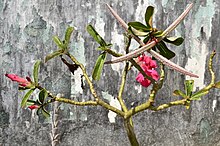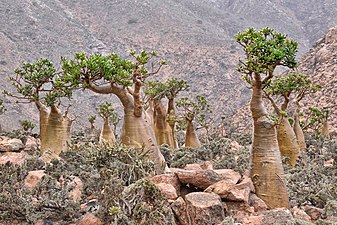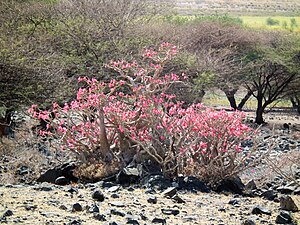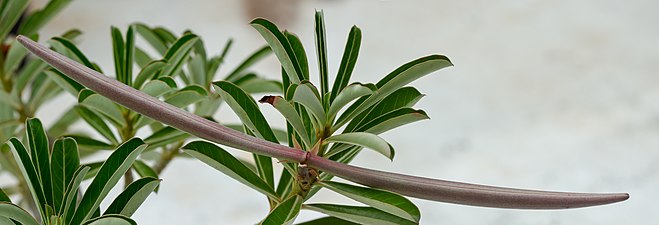bio.wikisort.org - Plant
Adenium obesum is a poisonous species of flowering plant belonging to the tribe Nerieae of the subfamily Apocynoideae of the dogbane family, Apocynaceae.[3] It is native to the Sahel regions south of the Sahara (from Mauritania and Senegal to Sudan), tropical and subtropical eastern and southern Africa and also the Arabian Peninsula. Common names include Sabi star, kudu, mock azalea, impala lily and desert rose. Adenium obesum is a popular houseplant and bonsai in temperate regions.
| Adenium obesum (Desert rose) | |
|---|---|
 | |
Conservation status | |
| Scientific classification | |
| Kingdom: | Plantae |
| Clade: | Tracheophytes |
| Clade: | Angiosperms |
| Clade: | Eudicots |
| Clade: | Asterids |
| Order: | Gentianales |
| Family: | Apocynaceae |
| Genus: | Adenium |
| Species: | A. obesum |
| Binomial name | |
| Adenium obesum | |
| Subspecies | |
|
See text | |
| Synonyms[2] | |
|
Adenium coetaneum Stapf | |
Description
This section does not cite any sources. (July 2022) |
It is an evergreen or drought-deciduous succulent shrub (which can also lose its leaves during cold spells, or according to the subspecies or cultivar). It can grow to 0.12–5 m (0.39–16.40 ft) in height, with pachycaul (disproportionately large) stems and a stout, swollen basal caudex (a rootstock that protrudes from the soil). The leaves are spirally arranged, clustered toward the tips of the shoots, simple entire, leathery in texture, 5–15 cm (2.0–5.9 in) long and 1–8 cm (0.39–3.15 in) broad. The flowers are tubular, 2–5 cm (0.79–1.97 in) long, with the outer portion 4–6 cm (1.6–2.4 in) diameter with five petals, resembling those of other related genera such as Plumeria and Nerium. The flowers tend to be red and pink, often with a whitish blush outward of the throat.






Taxonomy
This section does not cite any sources. (July 2022) |
Some taxonomies consider some other species in the genus to be subspecies of Adenium obesum.
Subspecies
- Adenium obesum subsp. oleifolium (South Africa, Botswana)
- Adenium obesum subsp. socotranum (Socotra)
- Adenium obesum subsp. somalense (Eastern Africa)
- Adenium obesum subsp. swazicum (Eswatini, South Africa)
Adenium swazicum is a critically endangered African species native to Eswatini and Mozambique, growing up to 0.7 m (2.29 ft) tall.
Adenium somalense is also native to Africa, inhabiting Tanzania, Kenya, and Somalia, and reaching heights of 5 m (16.40 ft), which makes it the largest of these four subspecies.
Adenium socotranum is native exclusively to the island of Socotra, and can grow to be 4.6 m (15 ft), but despite its small range, it is of least concern regarding endangerment.
Adenium oleiolium is near threatened in the wild and is the smallest of these subspecies, growing at the tallest to 0.4 m (1.31 ft).
Ecology
Caterpillars of the polka-dot wasp moth (Syntomeida epilais) are known to feed on the desert rose, along with feeding on oleanders.[4]
In areas with year-round warm weather, they can bloom throughout the year.[5]
Uses
Adenium obesum produces a sap in its roots and stems that contains cardiac glycosides. This sap is used as arrow poison for hunting large game throughout much of Africa[6] and as a fish toxin.[7]
Cultivation

Adenium obesum is a popular houseplant and bonsai[8] in temperate regions. It requires a sunny location and a minimum indoor temperature in winter of 10 °C (50 °F). It thrives on a xeric watering regime as required by cacti. A. obesum is typically propagated by seed or stem cuttings. The numerous hybrids are propagated mainly by grafting on to seedling rootstock. While plants grown from seed are more likely to have the swollen caudex at a young age, with time many cutting-grown plants cannot be distinguished from seed-grown plants. Like many plants, Adenium obesum can also be propagated in vitro using plant tissue culture.[9]
This plant has gained the Royal Horticultural Society's Award of Garden Merit.[10]
Symbolic and cultural references
The species has been depicted on postage stamps issued by various countries.[11]
See also
Gallery
- Close-up of stand of A. obesum var. socotranum, Socotra
- A. obesum var. socotranum, trunk of single extreme pachycaul specimen, Socotra
- Group of plants growing in scrubland, Tanzania
- Cultivated bonsai specimen with picturesquely contorted caudex and roots, Florida
- Cultivated specimen in Thailand flowering profusely.
- Large fruits on 30-cm tall plant, Chennai.
- 2-day seedling with seed husk 15 mm (0.59 in), Chennai.
- Group of plants at the campus of Ramakrishna Mission Vidyamandira in West Bengal, India.
References
- Botanic Gardens Conservation International (BGCI).; IUCN SSC Global Tree Specialist Group (2019). "Adenium obesum". IUCN Red List of Threatened Species. 2019: e.T62541A149059021. doi:10.2305/IUCN.UK.2019-2.RLTS.T62541A149059021.en. Retrieved 19 November 2021.
- "Adenium obesum". Germplasm Resources Information Network (GRIN). Agricultural Research Service (ARS), United States Department of Agriculture (USDA). Retrieved 2010-09-30.
- Schoch, C.L.; et al. (2020). ""Adenium obesum", NCBI Taxonomy: a comprehensive update on curation, resources and tools". National Center for Biotechnology Information. Archived from the original on 2020-04-17. Retrieved 27 Aug 2021.
- "Oleander caterpillar (Syntomeida epilais)" (PDF). UF/IFAS. August 2006. Retrieved 26 March 2018.
- "Is Adenium Obesum Poisonous to Dogs?". Home Guides | SF Gate. Retrieved 2022-05-14.
- Schmelzer, G.H.; A. Gurib-Fakim (2008). Medicinal Plants. Plant Resources of Tropical Africa. pp. 46–49. ISBN 978-90-5782-204-9.
- John 'Lofty' Wiseman SAS Survival Handbook, Revised Edition p. 240; William Morrow Paperbacks (2009) ISBN 978-1875900060
- D'Cruz, Mark. "Ma-Ke Bonsai Care Guide for Adenium obesum". Ma-Ke Bonsai. Retrieved 2011-05-11.
- Kanchanapoom, Kantamaht; Sunheem, Sunisa; Kanchanapoom, Kamnoon (5 December 2010). "In vitro Propagation of Adenium obesum (Forssk.) Roem. and Schult". Notulae Botanicae Horti Agrobotanici Cluj-Napoca. 38 (3): 209–213. doi:10.15835/nbha3834604 (inactive 31 July 2022). ISSN 1842-4309. Retrieved 26 January 2016.
{{cite journal}}: CS1 maint: DOI inactive as of July 2022 (link) - "RHS Plant Selector - Adenium obesum". Retrieved 23 February 2020.
- "Adenium obesum". StampData. Retrieved 24 March 2020.
External links
- Adenium obesum in West African plants – A Photo Guide.
- "Adenium obesum" at the Encyclopedia of Life
На других языках
- [en] Adenium obesum
[es] Adenium obesum
Adenium obesum es una especie de arbusto perteneciente a la familia Apocynaceae. Es también conocida como sabi star, kudu, rosa de invierno o rosa del desierto. Es nativa del este y sur tropical y subtropical de África y Arabia.[fr] Rose du désert
Adenium obesum[ru] Адениум тучный
Адениум тучный, или Адениум толстый (лат. Adenium obesum) — вид невысоких полукустарников или небольших деревьев семейства Кутровые (Apocynaceae) с утолщёнными в нижней части стволами.Другой контент может иметь иную лицензию. Перед использованием материалов сайта WikiSort.org внимательно изучите правила лицензирования конкретных элементов наполнения сайта.
WikiSort.org - проект по пересортировке и дополнению контента Википедии








